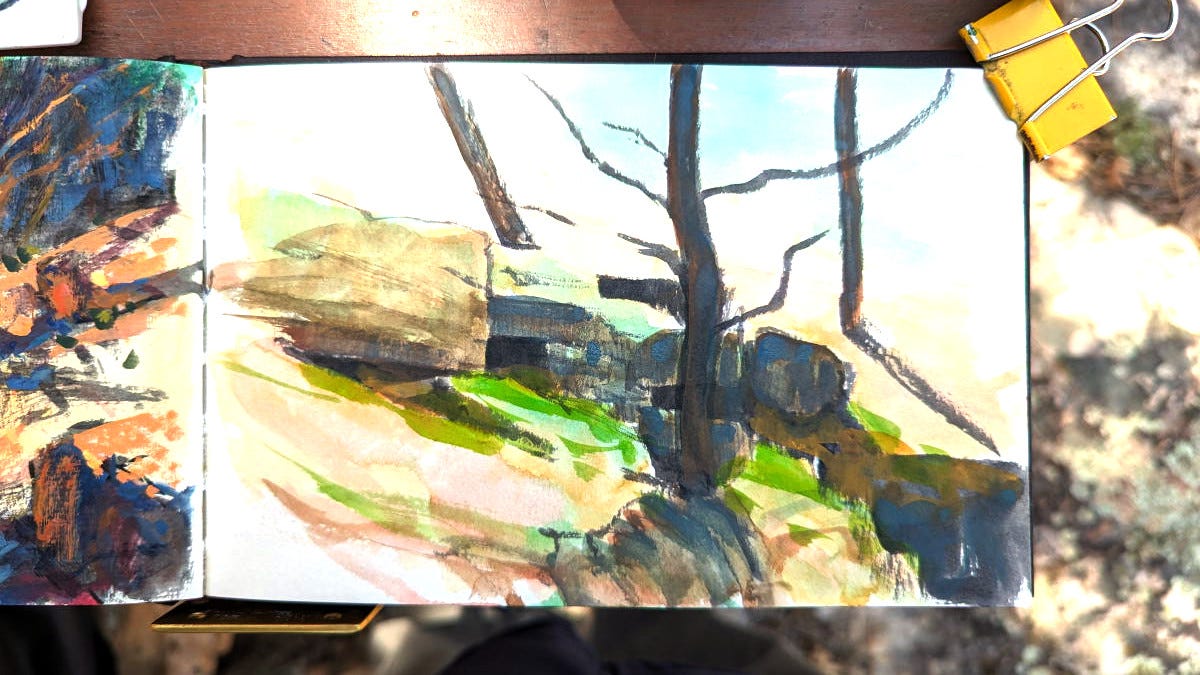(Above: My outdoor gouache setup and my latest “office”)
As most of you know, I'm a big fan of pan gouache. But some professional artists might think of pan gouache—wee dry cakes of pigment that sit in tiny depressions in a metal container—as the stuff of hobbyists. Since I'm a professional, I decided it was time to move into the big league and try gouache that comes in tubes.
I have a problem, though. I work in gouache only outdoors. And here in the sunny southwest, gouache—and any water medium, in fact—squeezed out of a tube tends to dry quickly. It almost immediately develops a thick skin that is hard to poke through with your brush, making it difficult to pick up and mix. Pan gouache doesn't have this issue. I can take a wet brush, swirl it over the cake, and get all the color I want, easily. (Granted, the pigment load is much less than with the tubed gouache, but I tend to use mostly transparent washes of color in my sketches, moving to the opaque only toward the finish.)
Yes, I know—I can use a Sta-Wet palette, which comes with a wettable sponge and a cover to keep the gouache moist, or I can use a mister. An artist friend has recommended trying Winsor & Newton's Watercolor Blending Medium, saying she's had good luck with that by dipping into it before dipping into paint, as it slows down drying. But that's just more stuff to take outdoors, and I want to keep my kit simple and light. I will try the W&N product, though, and see how that goes.
I haven't let all this deter me. I've gone out several times now with my tubed gouache, using a Portable Painter Palette to keep the paint in. This unit is very cleverly designed, with a couple of small buckets you can put water in. These hang off the two ends of the palette—something that doesn't work for me, because I like to sketch against a board (the wooden palette from a battle-worn French easel that is missing a few parts) and I have a closed, squat container for water that I prefer. The included brush brilliantly has a second, smaller brush concealed in its handle.
The Palette has pans to squeeze the gouache into. (I do this before heading out.) The pans are so small that it's hard to keep paint clean, but that's my fault, as I tend to not rinse my brush much between colors. I could mindfully clean the brush, but I'm a quick painter, and it would slow me down. A second brush? Maybe, but when I pick up another brush, I am not thinking about color but about size and quality of brush stroke. (I rarely use the palette's included brush, as it is small and encourages finicky work; I still take to the field my Richeson Travel Brush Set, which has a variety of sizes.) The W&N product mentioned above can also help rinse color out of a brush thus keeping the paint cleaner, and so taking that might help.
So, let's see...I'm not using either the two water buckets or the brush, so maybe this particular palette is overkill. Perhaps I should be looking for another solution. But I do want to give it, and the tubed gouache, a chance. (My secret I've discovered for handling the tubed gouache, which can be a bit goopy—don't worry about stroke accuracy and keep things loose.)
I think we artists should regularly try new products, mediums and techniques. Chances are, they're not going to work quite as expected at first. Rather than just discarding them immediately, we should give them a chance, a very generous chance. The practice will keep us young—and the little frustration we may encounter will only humble us and makes us appreciate the skill of others.
Here are a few photos:










Interesting. I wouldn't have thought of that issue with the tubed gouache, although I sometimes run into it myself working with acrylics even in the studio. With acrylics I'm more used to spritzing the palette with a spray bottle to keep the paint from skimming but it does still happen and can also make things too wet if I overdo it. I know of an acrylic artist who keeps his paint in an airtight fishing tackle box and keeps it closed except when he needs to add a small amount more to his mixing tray (which is a sta-wet palette).
What brand of gouache pans do you use? Once you wet the pan does it harden up the top once dry making the underlying color unusable? Or do you just scrap the top dried surface off?